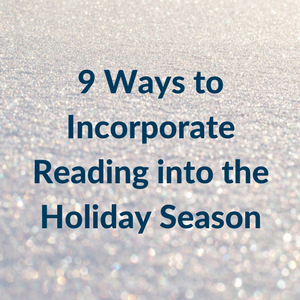9 Ways to Incorporate Reading into the Holiday Season
Posted by Tammi Brandon on 22nd Dec 2017
The Holidays are such a busy time of year. Sometimes during the hustle and bustle of the season, people find there isn’t much time left for reading. Here are some fun ways to fit reading with your children into this hectic time of year.
-
The Twelve Books of Christmas:
Just about everyone has heard the song “The Twelve Days of Christmas,” but what good is a partridge in a pear tree? And, seven swans a swimming…probably not the most practical gift. Instead, select twelve short books that your children will enjoy. Wrap them in gift wrap and open one each night to celebrate the twelve days of Christmas. Children and adults will enjoy snuggling together under a warm blanket and reading or listening to a quick story before bed.
-
Read the book before seeing the movie or television show:
Many children look forward to watching “A Charlie Brown Christmas” or “Rudolph the Red Nosed Reindeer” on television. In the days leading up the watching a holiday show, read the book together. Grab a bowl of popcorn or a cup of cocoa and enjoy time together talking about the book and movie.
-
Light the Menorah and light up young minds:
Make it a holiday tradition to read by candlelight during the eight nights of Chanukah. Poems or short stories read year after year become treasured childhood memories.
-
Learn about traditions:
While Christmas and Chanukah are two of the major celebrations, there are several other lesser-known holidays. Visit the library or local book store and look for books about the winter solstice, Kwanzaa, St. Lucia Day, Three Kings Day, Saturnalia, Omisoka, and Boxing Day. Learning about other traditions is fun for children and adults.
-
Audio books count:
When traveling to visit friends and relatives, grab an audio book and take reading on the go. Libraries loan a wide assortment of audio books – everything from preschool stories to long chapter books. Listening to an audio book makes those long car rides feel shorter.
-
Don’t forget the writing:
Have children write a Wish List, a letter to Santa, or sign their names in holiday cards. Encourage writing on different wintery surfaces such as pressing a finger to write on a frosted window or walking through the snow to write out large letters to spell a word.
-
Long lines = fun times:
Print out a copy of a familiar holiday story such as “Frosty the Snowman” or “Twas the Night Before Christmas” and keep it in your purse or wallet. When waiting in line at the store or in a restaurant, grab that story and begin reading it. When reading it, leave out certain words and allow children to fill in the blanks. It’s fun to hear how the story changes when children can change character names or events. “‘Twas the night before…Tuesday…when all through the…backyard…not a creature was stirring, not even a …police man…” and “Frosty the…teacher…was a jolly, happy soul, with a…hundred books…and flat tire…and a mouth made out of…spaghetti…”
-
Fireside fun:
Light up the fireplace, put on pajamas, and read together. Different readers can take turns reading or each reader can read and act out characters from the story. Maybe a different reader reads each night.
-
Try something new:
Whether it be a new recipe or a new game, encourage children to read the directions aloud. To make oral reading more fun, read in different voices. Try reading with an elf voice or the voice of an abominable snowman.
Even though this time of year is a busy one, be sure to make time for family reading. Doing so shows children that reading is fun and important. Children who are read to everyday – even if just for 10 minutes – do better in school, gain a deeper understanding of our language, and develop a rich and varied vocabulary. Make time to read today.
Tammi Brandon, M.Ed., CDP
Tammi Brandon is a Master Instructor and Education Consultant with Brainspring Educator Academy.
Bring Brainspring Orton-Gillingham multisensory instruction to your classrooms, transforming struggling K-12 readers into skilled learners through our effective, evidenced -based approach.


